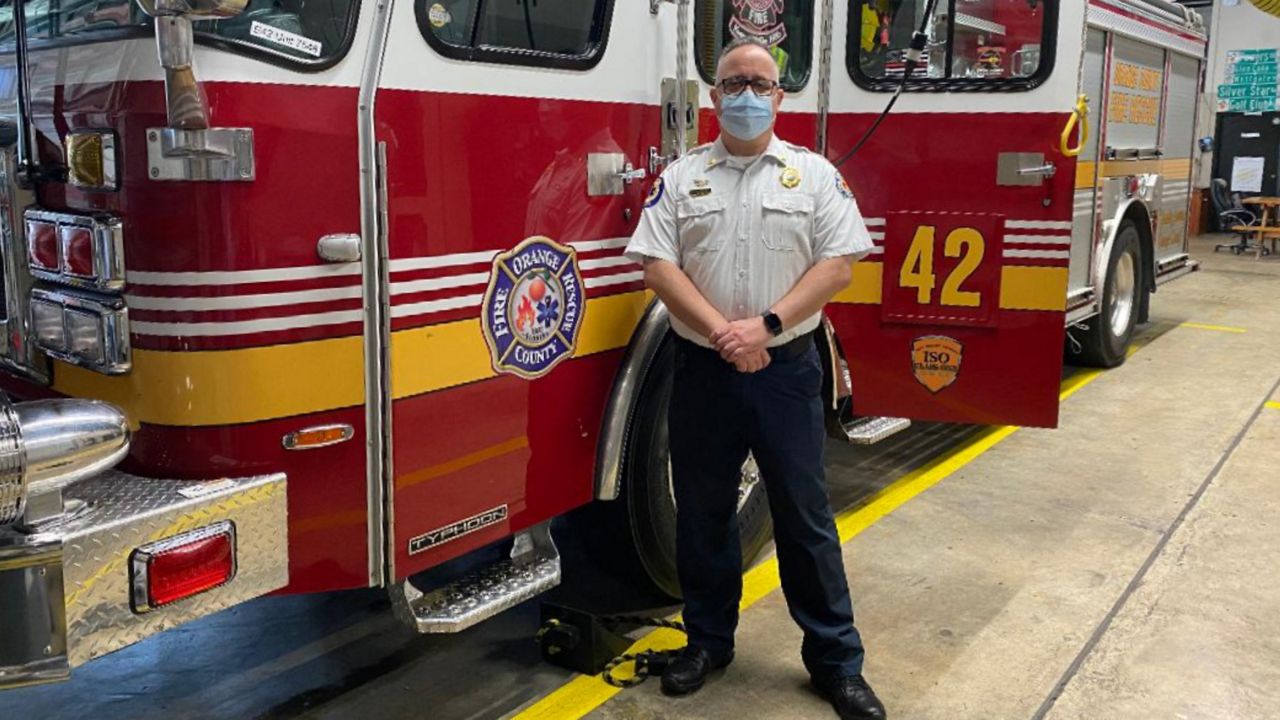ORLANDO, Fla. — Scott Egan says that when he and his team members became firefighters, they never imagined that they’d be administering vaccines during a pandemic.
What You Need To Know
- Orange County Fire Rescue official: 100 firefighters trained to give COVID shot
- Training to administer COVID shot builds on their training as paramedics
- Firefighters encountering seniors who are “extremely grateful” for getting the shot
- SPECIAL PODCAST: 5 Myths About the COVID-19 Vaccine Debunked by a Doctor
But that’s what they’re doing.
“Because that’s what we do,” Egan said. “We get out to the communities. We serve our citizens.”
Egan serves as battalion chief of emergency medical services for Orange County Fire Rescue, which touts 100 firefighters who have been trained to administer COVID-19 vaccinations.
Egan says nine firefighters administer shots six days a week to people age 65-over at the Orange County Convention Center. His teams also administer shots to senior residents at remote locations throughout unincorporated Orange County.
“We do what we can to make their lives easier or better and protect them for the long run,” Egan said.
For Spectrum News’s Vaccine Education Week, Egan discussed the training that he and his firefighters received to administer the shot and how they give it.
Certified paramedics join nurses and other health care personnel as workers authorized to administer the vaccine in Florida. Orange County firefighters double as certified paramedics.
To administer the shot, Egan said, certified paramedics and others must take a three-hour course from the Florida Department of Health.
The course covers the specifics of the COVID-19 vaccines, Egan said, “knowing that at your trained level, you already went over a lot of the basics” of administering vaccinations.
Q. Tell us about the training for administering the vaccines.
A. “The first thing they go over is vaccines in general: how they work in the body, the different types of vaccines, the development of vaccines over the years. That class is not only specific to COVID; it'll go over flu shots and other types of vaccines.
“So first you have to understand how those work within the body, and then they go over the specifics of how the different manufacturers (Pfizer, Moderna) require the medication to be stored, the requirements for administration of it, as far as drawing it up … how to prepare the syringes, the timelines, the differences between first dose and second dose of the different manufacturers.”
Q. Does the training cover some of the psychology in administering the shot — what to say to people who suddenly become hesitant or nervous?
A. “I would put that back in our core basic training” as paramedics … “We're coached in ‘bedside manner’ on how to work with a patient and inform them” in all types of situations. “So that's something that happens outside of just vaccines, when somebody starts an IV on someone or is administering a medication.”
Q. How many COVID-19 shots have you administered?
A. “I have probably done about 100. I'm on the administration side of the program, so I'm definitely low on my numbers compared to many others in the program. At the Orange County Convention Center,” firefighters are “seeing thousands a day, so they could be doing hundreds a day.”
Q. What are you hearing from seniors to whom you’ve given the shot?
A: “Everyone who we've interacted with is extremely grateful and just sharing stories, that they feel they could get back to seeing their grandkids again, or they feel a little safer going out of their house now. Those interactions have been fantastic.
“There have been some with concerned questions or nervousness. We've been able to relieve those by giving them the answers and letting them know what their expectations are for aftercare.”
Q. Are you required to administer the vaccine to any certain place in the arm?
A: “It needs to go into the deltoid, the muscle mass in the upper arm. It can be either side, left or right.
“There are alternative sites if somebody is unable to take a shot there or for different reasons, and there are other alternatives for those who can't receive a shot, maybe have a stent there … and that's all under the guidance of the CDC.”
Q. How do people react to getting the shot?
A: “The most common for a first-shot administration is a very sore arm. The arm will be tender and sore for up to a day or two, and that will absolutely go away in time. What we do encourage is moving the arm. If the pain is bad, we encourage them to put ice on it. If they wanted, they could take Tylenol or ibuprofen or whatever they're approved to take.”
Q: Have people complained of any immediate pain?
A: “Some remember vaccines from maybe back when they were younger … and I'd say most people who I interacted with said it was much less painful than they expected.”
Q. As a front-line health care worker, you said you’ve received both COVID-19 shots and that all of your firefighter paramedics have been offered the shots. You’re feeling OK?
A: “Yeah — great.”



